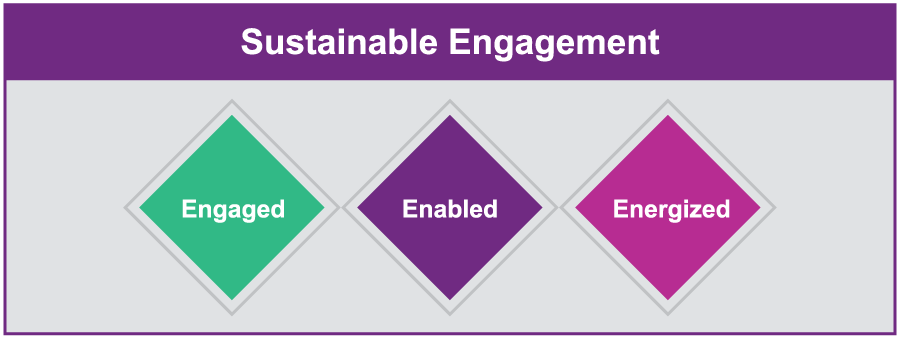It's easy to spot an engaged employee. It's that worker who takes extra time with a customer, stays late to complete a task, says good things about their employer, or even works the company t-shirt into their wardrobe rotation. But how do you put this magical quality into words to then track, trend, and understand it?
The core of employee engagement is a sense of attachment, those fuzzy warm feelings of membership with a company. But the examples above go deeper. They are about giving serious effort, often beyond the call of duty. The tricky thing about effort is that it needs to be supported and nurtured. Put another way: Taking extra time with a customer will only happen if that time can be put to good use and when an employee has the staying power to make it happen.
WTW defines employee engagement as the intensity of the employee relationship with an employer, marked by three elements:
(i) committed effort to achieve goals ('engaged'), (ii) in an environment that enables work ('enabled'), and (iii) energizes performance ('energized').
Employee engagement is thus a combination of those fuzzy, warm feelings and strong supports. WTW defines employee engagement as the intensity of the employee relationship with an employer, marked by three elements: (i) committed effort to achieve goals ('engaged'), (ii) in an environment that enables work ('enabled'), and (iii) energizes performance ('energized'). Because effort must be supported to be sustained, we talk about employee engagement as "sustainable" to capture its full picture. Let's unpick these three elements of engagement.
To give committed effort requires believing the goals of your exertion are worth it. Otherwise, why bother? To endure, such effort needs to spring from a pool of good will in completing tasks on behalf of the employer. We thus often talk about motivating heads, hearts, and hands. Effort must be grounded in truly believing in the goals of a company and feeling good about working there. We call this motivated effort the "Engaged" aspect of our definition.
In short, enabling work is making it easy to get things done. An employee will stay late to complete that one extra task if there are no obstacles to that work and the systems to deliver it are efficient. Barriers to meeting work challenges are frustrating and discouraging. We call this support to deliver the "Enabled" aspect of our definition.
Energizing employee performance is putting fuel in the tank. An employee fatigued from a day's work is unlikely to take that customer call at quitting time. They are running on empty. Such low capacity can come from high workloads, unsupportive colleagues, or highly stressful workplaces. These challenges eat away at accomplishment from work, no matter how much effort is exerted. We call this capacity to deliver the "Energized" aspect of our definition.

In short, the employee with sustainable engagement is engaged, enabled, and energized. They are ready and willing to give their all and thrive in an environment that supports their efforts and ensures they have the energy to excel. We measure this combination with about 6-9 questions in an employee engagement survey.
This sustainable employee engagement model is thus more predictive of performance than traditional definitions of employee engagement, which ignore the enabled and energized elements.
The risks from poor employee engagement are many. As workplaces chip away at the ability and fuel to deliver, employees are unsupported. As organizations fail to engage heads and hearts, employees detach. The worst case is full disengagement, a broken relationship in which effort is neither supported nor readily given. This destructive state is the employee who loses the customer, leaves early, and goes home to say the worst things about you and your brand.
Read more about WTW's definition of employee engagement and its power to predict performance: The Power of Three: Taking Employee Engagement to New Heights.
Angela supports WTW Software users by helping to design off the shelf content, based on thorough research and statistical analyses of large scale employee survey data. Her goal is to ensure that survey content is based on the latest and most robust research evidence. When she is not working, Angela enjoys films with her sons, walks with her Bernese Mountain Dog, and a good chat with friends at book club.